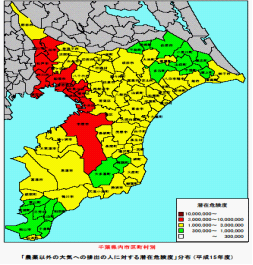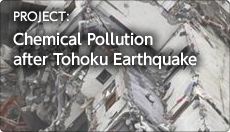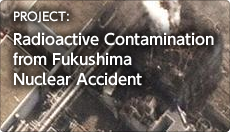
Jul,2007 : Implementation of Environmental Information Disclosure, PRTR, and Its Impact on Environmental Policies in Japan
Mar 18, 2012
Implementation of Environmental Information Disclosure, PRTR, and Its Impact on Environmental Policies in Japan: Toward Environmental Democracy Based on Precautionary Principles, Citizens’ Involvement.
(Paper Presented at the 2007 Beijing International Conference on Environmental Sociology, June 29-July 1, 2007, Renmin University of China)
Ryoichi Terada
(Faculty of Arts and Letters, Meiji University, Email: teradary@kisc.meiji.ac.jp)
1. Introduction
<1> “End-of-Pipe” Regulation in Industrial Pollution Era
As often mentioned, Japan suffered severe industrial pollution during the 1960s and the early 1970s, causing the upheaval of pollution victims’ and sufferers’ movements nationwide. Due to the strong pressure from the wide range of citizens, the national Government, once exclusively pro-economic growth, made a drastic concession and enacted some of the most stringent pollution control acts in the world at that time. Japan achieved a considerable success regarding the “command and control” pollution regulation at “the end of pipes” in the early 1970s. One of the reasons why the end-of-pipe regulations worked well to reduce pollutants at issue was that the number of pollutants, such as mercury, SOx, cadmium, and chromium, were limited and relatively easy to control at discharge processing. Symptoms of industrial pollution then, such as mercury poisoning and asthma, were often acute and directly physical. The cause and the effect were also relatively simpler than recent complex pollutants such as endocrine hormone disrupters, although it took several years for scientists to prove these pollutants as the cause of the symptoms.
However, the direct legal regulation on limited number of proven pollutants has been no more so effective recently, since varieties of chronic symptoms, including reproductive disorder, allergy, multiple chemical sensitivity, and so on, are supposed to be caused by diverse kinds of toxic substances. Suffice it to say that we are surrounded by tens of thousand of chemicals in daily life, many of which are suspected to be not only carcinogen but also endocrine disrupter and other potentially hazardous materials. Many of them, such as plastics and solvent, are not intended to be toxic like pesticide, yet later found to be hazardous, at least potentially. In addition, even materials that are not directly harmful to human body are sometimes proven to be destructive to the global environment. CFCs that cause ozone layer depletion and CO2 and other greenhouse gases are the examples.
<2> New Policy Alternatives in the Age of Environmental Risk
Under this “environmental risk” circumstance, “end-of-pipe” regulation is no more effective. Environmental policies that can cope with diverse potential environmental risks today are required to motivate wider range of parties to reduce total emission of each suspected substances in order to lower risks and uncertainty as a whole. The policy alternatives include the following measures.
1) Economic incentives and measures such as environmental taxation and subsidy (e.g. carbon taxation or tax deduction for low emission vehicles).
2) Technological innovation measures to substitute and to reduce toxic substances.
3) Voluntary actions by business corporations such as ISO 14001 environmental management and responsible care.
4) Environmental market incentives such as “green consumer movement”, “green purchasing”, or “socially (environmentally) responsible investment (SRI)”. And finally,
5) Informational incentives such as PRTR (Pollutant Release and Transfer Registers).
These policy measures are interrelated rather than functioning independently. Economic incentives tend to prompt technological innovation, or “ecological modernization” (Mol and Sonnenfeld, 2000). And information disclosure such as PRTR is supposed to function as one of the important resources for socially responsible investment or for voluntary environmental management activities of business.
According to Beck (1986), while production of wealth and its distribution have been regarded as the central issues in an industrial society, production, distribution, and definition of risk matter in a “risk society”. In my viewpoint, these new policies, environmental informational incentives in particular, play an important role for risk definition, evaluation, and control.
In 1960s and 1970s when pollution victims demanded compensation in Japan, for example, scientific information was far more monopolized among the government bureaucrats and experts. However, it seems that it was much easier to define what was the most serious issues and to construct the claim (Hannigan, 1995) in the 1970s, because the tragedy of the industrial pollution such as Minamata mercury poisoning and its causal relation was so obvious to everyone. Today, by contrast, potential risks of, say, dioxin, GM food, POPs, greenhouse gases, or UV-B are uncertain and difficult to evaluate for almost everyone. Even among well-informed scientists and environmental activists, it is not easy to prioritize the issues. Environmental issues and policy making have become more and more dependent on socially constructed “claim making” as Hannigan (1995) argues.
In addition, I would suggest that this situation leads to introduction of some of new principles such as “precautionary principles”, citizens’ participation principles, and information disclosure principles. These principles consist in important part of environmental democracy in broader sense in the age of “risk society”. Japan, as well as many of lately developed industrial societies in Asia, has been taking primarily top-down bureaucratic measures to regulate pollutant emission as I described earlier. I would also suggest that adoption of the new principles inevitably entails broader change in the policy making process; “from government to governance”. Japan, characterized historically as an authoritarian industrial state, has tended to make decisions on whatever issues almost exclusively by the government bureaucracy. Recently, however, the government started to open the door at least to some extent to the public and NGOs to make policies, through public comment opportunities, accepting the leaders of related NGOs to the consultation committees, and so on. This is partly due to international pressure such as the Rio Summit Principles, yet to certain degree in order to incorporate wider range of environmental stakeholders into decision-making processes to establish environmental governance in a risk society.
In this paper, I will examine in what sense and to what extent the introduction of the new policy principles is bringing about changes and effect in terms of risk control. Focussing on the implementation of PRTR in the beginning of the 2000s, its impact on business behavior and environmental movement strategies will be discussed.
2. The background of PRTR implementation
Pollutant Release and Transfer Registers are inventories of data on potentially harmful chemicals released and transferred by designated factories and sites. Release and transfer data are generally collected by national governments and the data are usually accessible to the public. Netherlands first introduced its prototypical system as early as in 1974 as EIS: Emission Inventory System, however, the primary purpose of the system was to collect resources for the government to design environmental policies. The first typical PRTR system, TRI: Toxic Release Inventory, was introduced in the United States in 1986, when the “Super Fund Act” was re-authorized to meet citizens’ demand of “community right-to-know”. TRI data, not only regional or local aggregate data but also emission data of each individual factories, are openly accessible by the public for the first time. TRI, as everybody can imagine, brought about a drastic impact on corporate environmental risk management as well as on strategies of environmental movement organizations.
Among the countries that adopted PRTR at the early stage, include the United Kingdom (PI: Pollutant Inventory, 1990), Canada (NPRI: National Pollutant Release Inventory, 1993), and Scandinavian countries. Outside Europe and North America, Australia implemented (NPI: National Pollutant Inventory) in 1994, South Korea in 1996, and Japan in 1999.
We can distinguish three stages concerning the institutionalization of PRTR. First, there had been several important chemical accidents and pollution in and around the United States in the early 1980s that promoted legislation of the Community Right-to-Know (TRI) Act in 1986. Secondly, with the success story of the U.S. TRI, Rio de Janeiro Summit of 1992 declared “Rio Principles” and “Agenda 21” which included articles on environmental information disclosure and the citizens’ involvement in environmental decision-making processes. These in turn encouraged the early followers in Europe and North America. Thirdly, the OECD (Organization for Economic Co-operation and Development) in the United Nations adopted a Recommendation on Implementing Pollutant Release and Transfer Registers in 1996. This recommended the OECD member countries, which produce sizable amount of world industrial goods and pollutant, yet without PRTR to implement within three years. With this recommendation, Japan finally decided to implement PRTR.
3. TRI and the Issue Framing as Environmental Justice and Risk Disproportionality
According to OECD (2000: 17), PRTR has multiple goals as cited below.
1) Fulfilling the public’s right-to-know
2) Identifying opportunities and encouraging pollution prevention
3) Encouraging cleaner production
4) Improving public participation in environmental policy decision-making
5) Identifying areas for action (e.g. hot spots of pollution or of a “specific” chemical) and setting priorities
6) Measuring progress toward environment goals and policy objectives
7) Monitoring policy performance and
8) Improving the public’s understanding of environmental issues
Among these, 1) the public right-to-know and 4) public participation in environmental policy decision-making have been primary concern for citizens potentially affected by hazardous chemicals from, for example, factory smokestacks, while policy makers and business people tend to be more interested in 2) encouraging pollution prevention and 3) encouraging cleaner production. In the United States where PRTR (TRI) was first launched, there had been several severe chemical accidents that threatened health of the near-by residents in the late 1970s and the 1980s.
Love Canal dioxin pollution that occurred in 1978 in a working class community from an abandoned toxic waste landfill site horrified the residents. This led to the legislation of the Superfund Act, or Comprehensive Environmental Response, Compensation, and Liability Act (CERCLA), that required not only polluters but also land owners strict liability to clean-up contaminated soil.
Tap water was contaminated with organic chloride solvent leaked from semi-conductor factories in Silicon Valley area in California in the early 1980s. A San Jose based grassroots environmental group, Silicon Valley Toxics Coalition (SVTC), together with other environmental justice groups requested local municipalities to disclose information on solvent and other chemical substance storage and release at factories. Workers in the factories had had access to the information on chemicals used in the factories for occupational safety reasons since the 1970s, as well as local fire department for the emergency. SVTC insisted that community residents living next to factories should also have access to this information. Some of the municipalities issued the ordinances that entitled the residents the “community right-to-know”.
An American subsidiary of a pesticide factory, Union Carbide, exploded in Bhopal, India, in 1984. It leaked fatal toxic gas, MIC, to the surrounding communities with casualties of more than three thousands. The same factory in the U.S. also had an accident, not as catastrophic as in Bhopal, and this strengthened the public opinion for “community right-to-know” legislation. At the same period, the fact that toxic waste dumping sites were located disproportionately in communities of people of color though the research by the GAO, which also attracted public attention to distribution of environmental risks such as toxic waste and pollutant from factories in terms of environmental justice. As a result of the lobbying by the environmentalists and strong support from public opinion, a new legislation, the Emergency Planning and Community Right-to-know Act (EPCRA) was added to the Superfund Re-authorization Act in 1986 and the U.S. established the first PRTR (TRI) in the world.
It seems that the information disclosure on potentially harmful substances from each individual factories and facilities has changed strategies of environmental movements as well as corporate environmental risk management strategies. Even though it is not illegal to discharge a certain chemicals within the limit, it would not be comfortable for CEOs, as well as other stakeholders, to see their own company is ranked as one of the top polluters in the states. Not only in terms of corporate social responsibility but also in terms of production efficiency, high levels of chemical emission may be loss both in terms of economy and ecology. Community residents adjacent to the factory are also highly concerned about the levels of toxic release naturally. This strongly motivates both parties to minimize the emission.
The first remarkable success SVTC achieved using TRI data was in 1988 when the first TRI data were publicized by the U.S. EPA. SVTC found the fact that a local IBM computer factory emitted the largest amount of CFCs nationwide. It was doubtlessly shocking news for the community that the largest ozone layer depletion source existed in their neighborhood, although CFCs were not directly harmful to them. They had a rally in front of the factory, demanding to phase out CFCs in their production processes. This campaign attracted strong media attention and IBM took immediate action to replace CFCs with harmless substances in spite of their extension time to use them for some more years. This quick response helped IBM to establish an image of an “environmentally friendly” computer producer.
This was one of the first prominent events that demonstrated TRI as a useful tool to encourage “cleaner production”, or ecological modernization among concerned business corporations. At the same time, TRI also enabled environmental movements to construct a new “framing” of environmental issues, “environmental justice”, based on pollutant release distribution data. In other word, TRI has potentiality to create this win-win situation.
After this success, TRI data were elaborated into several “environmental justice” websites where the public can search geographically pollution hot spots and their relationship with demographic data such as race and income levels. These include “Hot Spots” by SVTC and “Mapcruzin” at local and regional levels and “Scorecard” by Environmental Defense” nationwide. These elaborated PRTR websites were also developed by environmental groups outside the U.S. later on. “Factory Watch” by the U.K. Friends of the Earth” and “Toxic Watch” by Toxwatch Network” in Japan are the examples.
As figure 1 indicates, as a result of TRI data disclosure for seventeen years from 1988, total amount of pollutant emission has been dramatically dropped in 2005 to approximately 60 percent from the 1988 level.
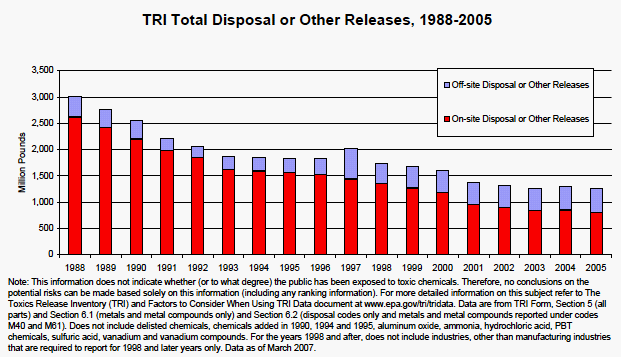
Figure 1. (The U.S. EPA, 2007, 2005 TRI Public Data Release eReport.)
4. The Rio “Environmental Democracy” Principles and the OECD Recommendation
The Rio de Janeiro Summit in 1992 dealt with series of newly emerged global, complex, chronic, and long-term environmental issues such as global warming, bio-diversity loss, ozone layer depletion, and hazardous chemicals. It is important to note that the necessity to cope with these emergent environmental agenda called for series of epoch-making progressive principles proposed at the Rio summit such as information disclosure, precautionary principles, and citizen’s involvement in the environmental decision making process. I would dare to call them “environmental democracy principles”, or even “environmental informational democracy principles”. It is doubtless that these Rio principles affected more or less radically the manner in which both environmental policies and environmental actions were made.
One typical example may be the worldwide diffusion of PRTR among primarily North American and European industrial societies at the first stage such as Finland (1988: first year of data collection), Denmark (1989), the U.K. (1991), Norway (1992), Canada (1993), Belgium (1993), Ireland (1995), and Italy (1995). The OECD started a follow-up work right after the Rio Summit in 1993 on PRTR implementation among its member countries, all of which are highly industrialized and largely responsible for emission of pollutants and other environmental burden.
The Rio Principle 10 reads:
“Environmental issues are best handled with the participation of all concerned citizens, at the relevant level. At the national level, each individual shall have appropriate access to information concerning the environment that is held by public authorities, including information on hazardous materials (Italic added) and activities in their communities, and the opportunity to participate in decision-making processes. States shall facilitate and encourage public awareness and participation by making information widely available. Effective access to judicial and administrative proceedings, including redress and remedy, shall be provided”.
And the “Agenda 21, chapter 19” reads:
“19.4. Six program areas are proposed:
(a) Expanding and accelerating international assessment of chemical risks;
(b) Harmonization of classification and labeling of chemicals;
(c) Information exchange on toxic chemicals and chemical risks;
(d) Establishment of risk reduction programs;
(e) Strengthening of national capabilities and capacities for management of chemicals;
(f) Prevention of illegal international traffic in toxic and dangerous products”.
The italicized part of the “Principle 10” and following clauses (c), (d), and (e) of the “Agenda 21, chapter 19” are directly related to the PRTR recommendation. In addition, based on the clause (b), “Globally Harmonized System of Classification and Labeling of Chemicals” was recommended by the U.N. in 2003, which is now scheduled to be implemented in 2008 in Japan (and, of course, in many other industrial countries as well). Also the clause (d), Establishment of risk reduction programs, seemed to motivate the U.N. Strategic Approach to International Chemicals Management (SAICM) program proposed at the 2002 Johannesburg World Summit on Sustainable Development. The goal of SAICM is to ensure that, by the year 2020, chemicals are produced and used in ways that minimize significant adverse impacts on the environment and human health. It is important to recognize that PRTR is not an isolated policy tool but one of the series of international comprehensive policies to minimize chemical hazard and its potential risks based upon the “precautionary principles”.
After the PRTR recommendation, Australia (1998: first year of data collection), Korea (1999), Japan (2001), and Switzerland (2001) joined to PRTR system as the third group.
While the number of reported chemical substance ranges from 666 in the U.S. to 90 in Australia and the area of industries that is required to report the emission data differs considerably in detail, the objectives of PRTR seem to be similar throughout the member countries. Yet there are some significant differences. For example, although many of the Western countries are willing to admit the idea of “community right-to-know” and ready to provide facility-specific release and transfer data open to the public, Japan and Korea hesitated to adopt at least at the beginning. While most of the early group publicize only pollutant release and transfer from factories and facilities, Japan and Australia in the later group also publicize estimated release from diffuse sources such as automobile, households, and farmland.
It would be of my interest that to what extent and how these differences do with the bureaucratic structure of the national governments or the characteristics and political influence of environmental movement organization in each countries in the course of future research. However, I will focus on the effect of PRTR implementation in the strategies of business corporations and environmental movements here.
5. PRTR Implementation in Japan and its Impact
I have two hypotheses concerning the impact of PRTR implementation in Japan (or possibly in any other societies) on changes in corporate behavior to promote ecological modernization and changes in strategies of environmental movements to pressure pollutant releasing facilities. The first one is the “economic incentive” hypothesis that PRTR would stimulate economic or market incentives for producers to pursue ecologically rational innovation to reduce pollutant emission. To achieve better performance at the publicized PRTR database is also important to meet the “corporate social responsibility” needs from the shareholders. Reducing pollutant emission through, for example, elaborating closed systems will also rationalize the production process both in terms of economy and ecology.
The second hypothesis is “environmental justice claim” or “environmental informational democracy” hypothesis that, through PRTR information disclosure, at least some sort of disproportionality in environmental risk distribution would be recognized that stimulates justice oriented environmental claim making. I did not actually expect that disproportionate risk distribution would be as clearly discernible as in the United States. Nevertheless, at least it is plausible that the more detailed information becomes accessible, the more active environmental movement action would be as well as citizens’ involvement.
Receiving the OECD recommendation, the government of Japan designated the Environment Agency (the Ministry of Environment from 2000) and the Ministry of International Trade and Industry (the Ministry of Economy, Trade, and Industry from 2000) as the administrative bodies in charge. That suggests that PRTR was not a purely environmental policy but also a part of industrial policy dealt by the MITI in Japan. The result of this, it seems to me, is twofold. Citizens’ involvement in the PRTR implementation seemed to be threatened in a sense by the pressure from business trade organizations and pressure groups, leading to Japanese PRTR without any statements on “community right-to-know” or open information disclosure on facility-specific emission data, on the one hand. However, on the other hand, the fact that PRTR was firmly incorporated in industrial policies under the strong leadership of MITI considerably authorized and legitimatized PRTR system itself so that it could obtain wide range of cooperation from business sectors.
The two government agencies started technical feasibility studies in 1996 and actual pilot data collection in 1997. Regarding the PRTR Act, the consultative committee had a controversy over the data disclosure. The representatives of industrial organization resisted it, while the representatives of consumers and environmentalist claimed it. The committee made a compromise between two opinions that only local aggregate data would be publicized and facility-specific emission data would be offered on request with some fee of charge. However, the Toxic Watch Network, one of the representing environmental NGOs in toxic chemical issues, obtains the facility-specific emission data regularly from the government agency and publicizes it as an easily accessible database to the concerned citizens free of charge. So the facility-specific database is virtually disclosed, yet the fact that the government does not formally recognize “community right-to-know” as the goal of this legislature should be considered as a significant defect of the Japanese PRTR.
The Japanese PRTR requires facilities, classified in 45 industrial categories, including mining, utility, waste management, and manufacture, with 21 or more employees, and using more than 1 ton per year of the 354 designated hazardous chemical substances, to submit their pollutant release and transfer data. In 2005, a little more than forty thousand reported their emission data. The total amount of release and transfer reported by these facilities is 490 thousands tons nationwide in 2005.
As the PRTR system in Japan launched late among the OECD countries, however, it has a few late comers’ merits. In addition to collected data from facilities, the Japanese PRTR agencies also announce estimated data on emission from small scale, report-exempted facilities and from diffuse sources such as automobile, households, and farmland. Theoretically speaking, this comprehensive data cover total emission of the designated 354 kinds of pollutants in each approximately 2000 municipalities all over Japan. However, this does not directly indicate the degree of hazardous chemical risk, because each of 354 substances has different levels of risk. The Eco Chemistry Institute, a university-annexed institute, calculated health and environmental risk from these 354 pollutants in each municipality, calculating emission volume multiplied by risk coefficient. This enabled overall geographic distribution of chemical risk throughout the country to examine whether or not there is serious disproportionality.
Let us look at the example of Chiba Prefecture adjacent to Tokyo, of which municipalities vary from heavily industrialized cities to typically rural village in Figure 2. We can recognize nearly ten times of risk difference between high risk, red areas and low risk, green areas.
Figure 2, A Risk (air born, human health risk) Distribution Map, Chiba Prefecture
(http://env.safetyeng.bsk.ynu.ac.jp/ecochemi/)
Figure 3. Is a two-dimensional plot of added economic values (billion yen) and pollutant emission (ton) of ten different industrial sectors nationwide, as of 2005 PRTR data. Added value and amount of emitted pollutant do not positively correlate, instead rather differentiated. In other word, this support what Freudenburg (2004) suggests “disproportionality”. There are some sector with high added value and low emission such as automobile and machine industry. Whereas at the opposite corner, there are some with low added value and higher emission such as nonferrous metal and textile. This differentiation or “disproportionality” suggests, as Freudenburg argues, there is room for the latter to promote ecological modernization.
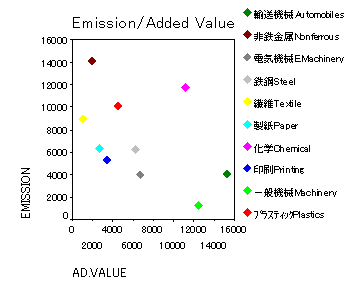
Figure 3. Added Economic Values and Pollutant Emission by Industrial Sectors
© Ryoichi Terada, 2007
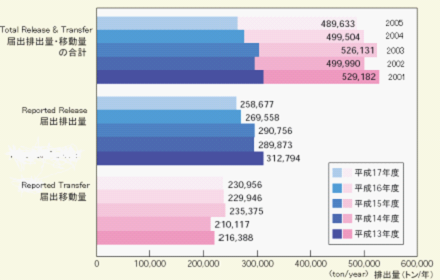
Figure 4. Total Reported Release and Transfer 2001-2005
The Ministry of Environment, 2007
Figure 4 indicates five year transition of the nationwide PRTR data (reported release and transfer). We cannot compare these data constantly, as only those facilities using 5 tons or more of 354 chemicals were required to report during the first two years, while the threshold was lowered subsequent years down to 2 tons. Nevertheless, we can recognize constant reduction of release in particular. If we compare the year 2003 and 2005, reported release decreased 11 percent and release and transfer together decreased 7 percent.
The next and final question is whether this reduction has been realized primarily by economic, market motivation to promote ecological modernization or by the pressure from some sort of environmental justice related claim making.
Fortunately or unfortunately, we haven’t had detected seriously challenged disproportional risk distribution or dangerous hot spots of pollutant since the beginning of PRTR data disclosure. This may be due to relatively homogeneous characteristic of demographic structure among communities in Japan. In addition, even if PRTR data have been easily accessible, it is generally not so easy for lay citizens to understand how seriously they are exposed to pollutant risks through the data. Even for journalists, chemical risk is not easy topic to attract attention from readers unless serious contamination or accidents occur. It was also unfortunate that on the day when the first PRTR data were to be publicized, on March 20, 2003, the U.S. Forces started attacking Iraqi troops. Although quite a few journalists prepared news articles on PRTR, most of the newspaper pages were filled with news flashes on the war.
While PRTR has neither attracted enough media attention nor raised concern among citizens in general, some of devoted environmental groups have been working on with specific concern on PRTR. Advocacy groups such as the Toxic Watch Network, Eco Chemistry Institute, and Citizens against Chemicals Pollution considerably contributed to the dissemination activities of PRTR both at national and local level, establishing international information exchanging relationship with overseas movement groups on PRTR, and giving pressure to the government as well. Some municipality like Kanagawa Prefecture elaborated local emission maps of each cities and towns to specify pollutant reduction goals for each of them. Since the first data disclosure, some of concerned local citizens and corporations have had “risk communication meetings” based on the PRTR emission data of their production sites to motivate and promote further corporate effort to reduce pollutant emission. Many of progressive factories voluntarily disclose their PRTR data on their environmental reports.
Business corporations have had to adjust themselves to quickly developing new environmental regulations including PRTR, RoHS (Restriction of Hazardous Substances), ISO14001, REACH (Registration, Evaluation, Authorization of Chemicals), GHS (Globally Harmonized System of Classification and Labeling of Chemicals), and so on. I often observed more business participants than citizens or activists at PRTR teach-in held by environmental groups for citizens.
According to the Ministry of Environment opinion survey for business corporations on PRTR in 2004, 39 percent of the respondents answered that they had reduced pollutant release through measures taken by themselves. Two third (68 percent) of the same respondents answered that they took these measures voluntarily.
From these overall observations, I would conclude that the major momentum by which the amount of pollutant release and transfer has been constantly reduced has come rather from the urgent business concern to adjust themselves to changing international regulatory condition on environmental burdens than from direct pressure from environmental movements. Nevertheless, it is also true that the implementation of PRTR legitimated environmental claims such as risk information disclosure claims and claims to promote NGOs and citizens involvement in environmental decision-making processes.
6. Conclusion
Between two hypotheses concerning the positive impact of PRTR to reduce pollutant risks, “economic or market incentives” and “environmental justice claim” hypotheses, the former have been more significant factors to stimulate ecological modernization and environmentally rational innovation, at least when I estimate the factors quantitatively. As mentioned earlier, PRTR is not an isolated policy innovation, but one of the consistent series of progressive policies since the Rio Summit based on the new principles such as “precautionary principles”, “environmental information disclosure”, and “citizens’ involvement”. Business corporations have been driven by the necessities to adapt themselves to this rapidly changing international environmental regulatory circumstance in order to survive.
This does not necessarily mean that environmental movements and citizens’ involvement are secondary in importance or dependent on the business environmental order. But rather, intensified environmental claims from the NGOs and citizens in turn bolsters and legitimate corporate environmental innovation actions. The more citizens evaluate “environmentally benign” companies and goods in the market, the more corporations are motivated to catch up.
In the broader context, PRTR implementation and subsequent environmental policy innovation brought about magnificent potential for new social and institutional changes not only in terms of environmental policies but also expanding basic human right to have access to information which has been hitherto monopolized by the bureaucracy or by the scientific expertise, for example. In this sense, PRTR and related implementation can be a catalyst and a basic infrastructure of “environmental informational democracy” toward sustainable economy and society.
References
Beck, U., 1986, Risikogesellschaft. Frankfurt/M.: Suhrkamp.
Freudenburg, W.R., 2004, “Toward Resolving the Conflict between ‘Environmental State’ versus Environmental Collision Perspectives: Considering the ‘Double Diversion’. Paper presented at the 2004 RC24 Conference in Seoul, Korea.
Hannigan, J., 1995, Environmental Sociology: A Social Constructivist Perspective. London, Routledge.
Mol, A.P.J. and D.A. Sonnenfeld, 2000, “Ecological Modernization Around the World: An Introduction”, Environmental Politics 9(1):3-16, Spring 2000.
OECD, 2000, Presentation and Dissemination of PRTR Data: Practices and Experiences. OECD.

